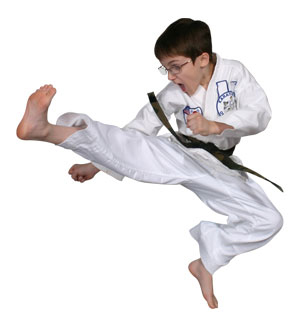TAEKWONDO SYLLABUS

There are rules of the Do-Jang (training
hall) which must be observed at all times.
These are the discipline side of the Martial
Arts. We must treat each other with respect
and always be friendly and leave any ego’s
outside the Do-Jang. After all we are all
here to have fun.
FITNESS
Every class has a workout of one form or
another. This has the obvious benefit of
keeping you fit in general but also means
that if you decide to take your sparring
seriously, you will be able to spar for
longer with less effort. A useful ability if
you want to compete.
FLEXIBILITY
Along with fitness, we perform a lot of
stretching. We use 4 types - dynamic, static
active, static passive and isometric and
each is used in the appropriate part of the
class. Flexibility is very important in Tae
Kwon-Do as we perform a lot of kicking
techniques. However, you do not have to be
flexible to start, you don’t have to be able
to kick high.
PAD WORK
This is basically where students practice
techniques against a partner holding a pad
and feel what is like to hit something. This
means that students can develop proper
balance for when hitting a target (different
from kicking air), practice generating power
and its a great stress buster!
LINE WORKS / ROUTINE
Techniques have to be learnt and practiced
before trying them out. Here is the main
part of this learning. Techniques are very
stylised but develop the correct muscles to
perform the techniques for real. Routines
are pre-set groups of these exercises which
are used for beginners to practice and as a
general warm up.
SET SPARRING KATAS
These are sets of techniques performed with
a partner as if having a fight. Obviously no
one would ever fight like this but it does
develop timing, distance, control and gives
students a feel for what it is like to face
up against somebody and have punches and
kicks thrown at them - without fear of
getting hurt.
ONE STEP SPARRING
This is semi-free form of sparring.
Techniques are performed with control but
students have to defend themselves against a
single attack from a partner. Any and all
counter techniques are allowed and it is a
good prelude to self-defence techniques.
After all it’s harder to defend against a
straight punch than a bar-room style swing.
SELF DEFENCE
It is a regrettable fact that there are
times when some of us will have to confront
a potentially dangerous situation. Here we
develop skills to protect yourself. The main
emphasis is on conflict avoidance and not
having to get into a fight in the first
place. If, however, you have no choice then
we practice realistic and practical
techniques to counter a variety of
situations.
PATTERNS
Patterns are sometimes better known as ‘POOMSE’.
These are properly executed techniques
against one or more imaginary opponents in a
pre-set form. Each grade must learn a
progressively more difficult pattern to
progress through the grading system. Each
pattern has an interpretation from Korean
history which must be learnt.
SPARRING
Though this is strictly speaking an optional
part of the syllabus, everybody has a go
because it is so much fun! Students wear
protective hand and feet pads and ‘fight’
each other according to a strict set of
rules governing acceptable target areas and
levels of contact. It is a ‘semi-contact’
sport, meaning that though students do hit
each other, they only make contact for
points and are not trying to hurt each
other.
PROGRESSIVE SPARRING
Again an optional part, usually only
performed by senior grades. Here the levels
of contact are brought right down for safety
reasons. Students can use almost any
technique to almost any area of the body,
making sparring very realistic. Knees,
elbows, sweeps, throws and take downs are
allowed. Multiple opponent sparring also is
incorporated.
BREAKING
Only done by senior grades, techniques are
performed against either wooden or special
plastic boards. This is to demonstrate power
and build confidence that the techniques do
work.
